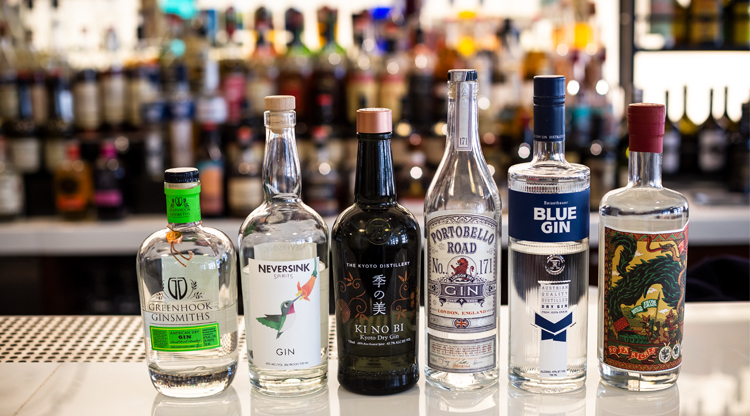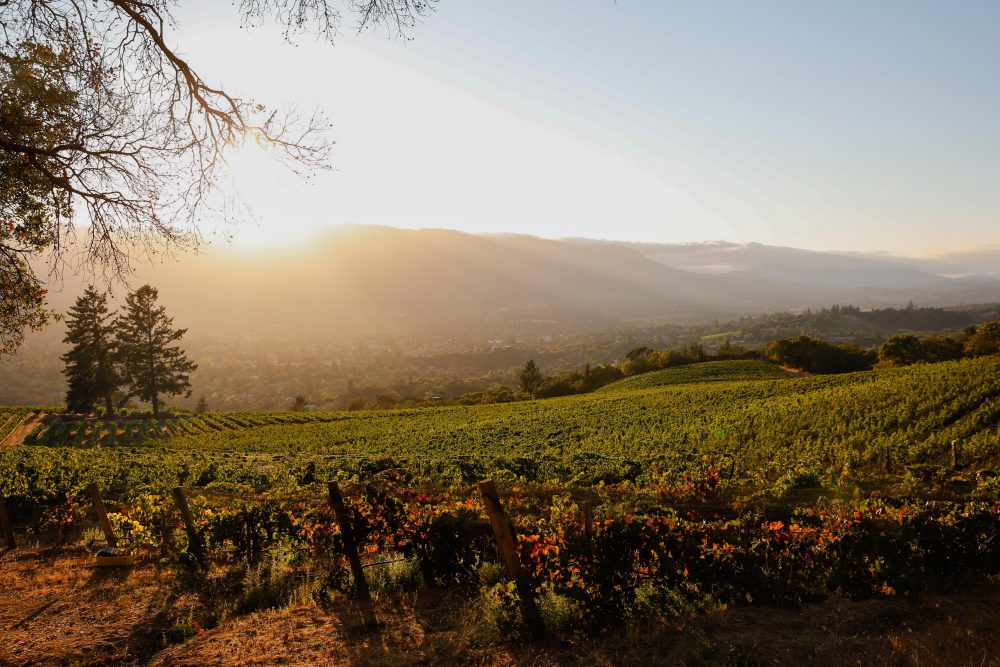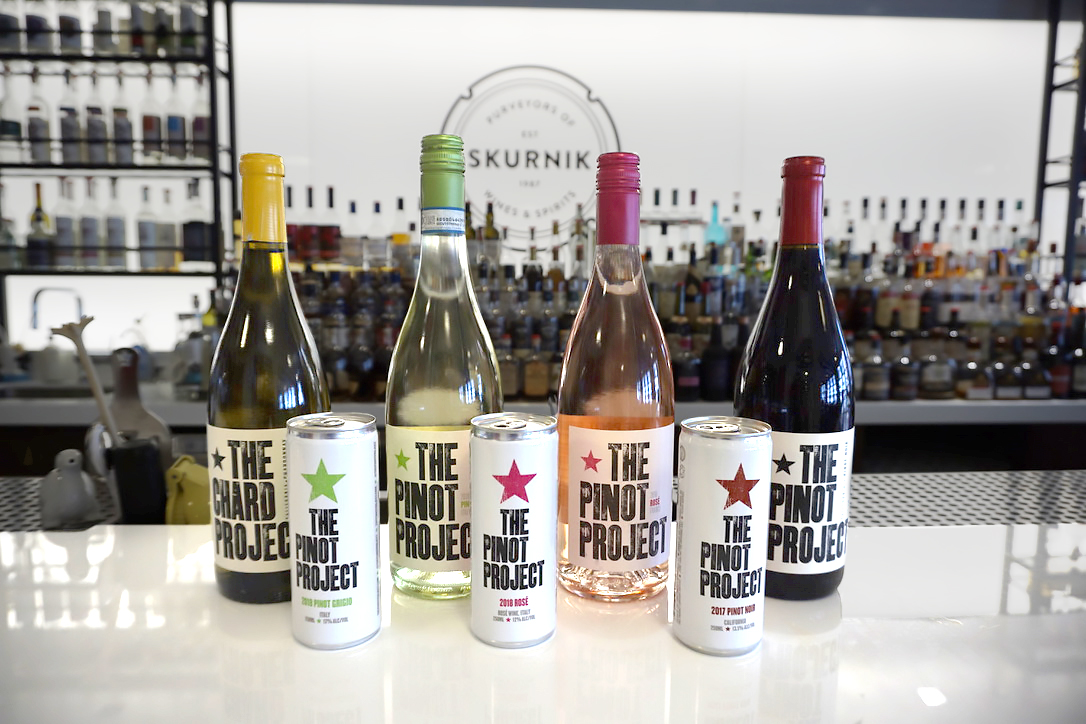While there is never a wrong time to enjoy gin – that bright, refreshingly piney, clear spirit – we do think that spring and summer are an especially right time to enjoy this long-lived and historically exciting spirit. Rife with stories from the terrible 18th-century gin craze called “the mother’s ruin” and followed by the “bathtub gin” of the Roaring Twenties, gin has long been loved and but has also been occasionally reviled.
Fast-forward to the present day and there have never been more options, and more new gins are being produced all the time. Gin is enjoying a resurgence, and we at Skurnik are joining in with a half-dozen gins to choose from! All six are unique and come from all different parts of the world. We are shining a spotlight on these producers here, highlighting their gin as features in some excellent cocktails and sharing some of our favorite anecdotes from our conversations with them.
Blue Gin
WHERE: Axberg, Austria
STYLE: London Dry Gin
ABV: 43%
BASE SPIRITS: Estate-grown Mulan wheat
BOTANICALS: 27, including juniper, almond, hops, lemon, angelica, cilantro, turmeric, and licorice.
Hans Reisetbauer has been producing gin since 2006. As an established producer of eaux-de-vie, his Blue Gin was born of his true love of gin as well as the refreshing gin and tonic. He took three years to get the recipe right and finally settled on 27 different botanicals. He and his team also produce a sloe gin and a version that is aged in oak.
We featured his classic “London Dry” style ‘Blue Gin’ in a Tuxedo #2.
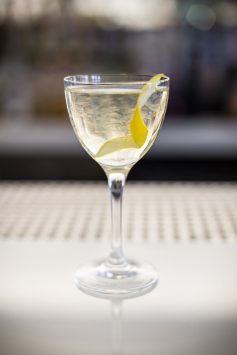
Tuxedo #2
- 2 oz. Blue Gin
- .75 oz. Vermouth Routin Dry Vermouth
- .25 oz. Caffo Maraschino
- 2 dashes of absinthe
Stir in mixing glass and serve up in a coupe or a Nick & Nora, and garnish with a lemon twist.
When the team at Reisetbauer aren’t drinking Blue gin and tonics they are patriotically drinking Grüner Veltliner from Bernhard Ott.
Greenhook American Dry Gin
WHERE: Greenpoint, Brooklyn
STYLE: vacuum distillation
ABV: 47%
BASE SPIRIT: Italian wheat
BOTANICALS: 10 different botanicals: juniper, cinnamon, chamomile, coriander, elderberries, elderflower, galangal root, lemon, orris, sweet orange
Steven DeAngelo has been producing what he cheekily terms “American” Dry Gin since 2012. Like Hans Reisetbauer, Steven loved gin – and gin and tonics – and decided to hang up his tie and get to work producing his favorite spirit. Greenhook Ginsmiths also produces an Old Tom Gin, a Beach Plum Gin, and recently added a ready to drink canned gin & tonic.
We decided to highlight Greenhook’s floral notes and make a classic Aviation.
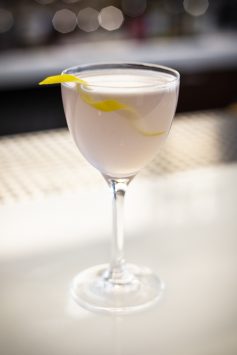
Aviation
- 1.5 oz. Greenhook Gin
- .75 oz. lemon juice
- .5 Caffo Maraschino
- .5 oz. Giffard Crème de Violette
Shake ingredients together and serve ice cold up with a lemon twist or edible violet.
We asked Steven what the biggest misconception around gin is. “I’ve heard [many] people tell me that gin makes them crazy… which seems hard to believe… Impossible really. Although I suppose if you drink enough of anything you could get a little crazy.”
Ki No Bi Gin
WHERE: Kyoto, Japan
STYLE: distilled separately and blended
ABV: 45.7%
BASE SPIRIT: Rice
BOTANICALS: Juniper, Orris Root, Hinoki (Japanese Cypress,) Yellow Yuzu, Lemon, Green Tea (Gyokuro,) Ginger, Red Shiso, Bamboo Leaves, Sancho Peppercorns, Kinome (Prickly Ash)
Ki No Bi gin launched in 2017 and is delicious as a stand-alone drink, but we think dry, elegant gin just screams to be had as a classic martini. We paired it with Lustau Vermut Blanco for a hint of sweetness and three olives to bring out the savory botanicals like Sancho peppercorns.
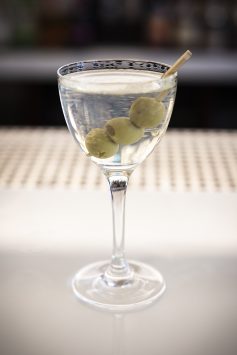
Martini
- 2 oz.s Ki No Bi Gin
- 1 oz. Lustau Vermut Blanco
Stir in a mixing glass and serve up with olives or a twist!
Neversink Gin
WHERE: Portchester, New York
STYLE: botanicals in still
ABV: 43%
BASE SPIRIT: New York State apples
BOTANICALS: juniper, coriander, star anise, cardamom, angelica, orris, cinnamon, elderflower
Yoni Rabino and Noah Braunstein have been producing gin since 2016, and in 2018 switched to a full apple-based distillate. They believe the apple base pairs perfectly with the baking spice botanicals they’ve chosen to highlight.
We’ve followed their lead and added a little honey and lemon for a Bee’s Knees.
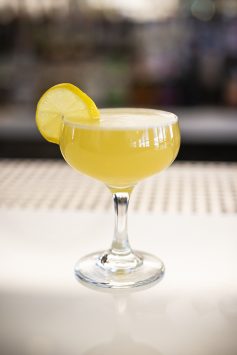
Bee’s Knees
- 2 oz. Neversink Gin
- ¾ oz. lemon juice
- ¾ oz. honey syrup
Shake and serve up with a lemon wheel garnish.
When asked their favorite gin other than Neversink, Yoni and Noah like another fruit-based and juniper-forward gin: Mahon, hailing from Spain. Yoni believes the biggest misconception around gin is that “gin is a ‘cheap’ spirit that always needs to be mixed to be drinkable. A good gin should be enjoyable served neat, but even more exciting when mixed in a cocktail that allows the nuances and botanicals to sing.”
Portobello Road Gin
WHERE: London, England
STYLE: botanicals in still (London dry gin)
ABV: 42%
BASE SPIRIT: English wheat
BOTANICALS: juniper, coriander, angelica root, orris root, lemon peel, orange peel, licorice root, cassia bark, nutmeg
Eight years ago, in 2011, Tom Coates, Jake Burger, and Ged Feltham started distilling above their cocktail bar: the Portobello Star at number 171 Portobello Road. Their goal was to create a London Dry that would work in a negroni, martini and gin and tonic.
Here we highlight their gin on a slightly more unique drink, but one that’s still a classic: the Diamond Fizz.
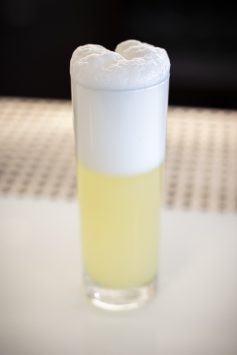
Diamond Fizz
- 2 oz. Portobello Road Gin
- ¾ oz. lemon juice
- ¾ oz. simple syrup
- 1 egg white
- 1 oz. Champagne, Duc de Romet NV ‘Prestige’ Brut
Combine all ingredients – except Champagne – in a shaker. Dry shake first, then add ice and follow with a wet shake. Pour the ingredients into frozen fizz glass, place in freezer for one minute, remove glass from freezer and add Champagne let foam build up above glass.
On the rare occasion that Tom Coates is NOT drinking a G & T – or his favorite, a gin sour: “It would be a good pint of English bitter. Perhaps the two most British of drinks!! G&T’s and pints of bitter in a country pub sounds like heaven!”
Tom feels the biggest misconception around gin is that London Dry Gins must be made in London:
“This is not the case… you can make London Dry Gin anywhere in the world, you just have to stick to certain rules and regulations to put those three renowned words on your bottle.
In brief: The gin has to be made from a neutral grain spirit, during distillation it is flavored predominately with Juniper and any other botanicals and cannot include any other artificial flavors. It also should be bottled at a minimum of 37.5% ABV.”
Vanagandr
WHERE: Galicia, Spain
STYLE: botanicals in still (London Dry Gin)
ABV: 43%
BASE SPIRIT: Italian wheat
BOTANICALS: juniper, angelica root, cassia bark, coriander seed, sweet orange peel, lemon peel, orris root, green cardamom, nutmeg, licorice, Ceylon cinnamon
Vanagandr, from Galicia in Northwestern Spain, named their gin after an infamous wolf from Norse mythology – named Vanagandr. Their water is an important part of their process and comes from the Agua de La Coruña plant, known for the softest waters in Spain. Enrique Peña only produces less than 500 bottles per batch. We couldn’t help but make a Spanish-style gin and tonic; now famous all over the world, one cannot go to a bar in Spain without seeing a balloon-style glass filled with ice, tonic and various fruit and herbs.
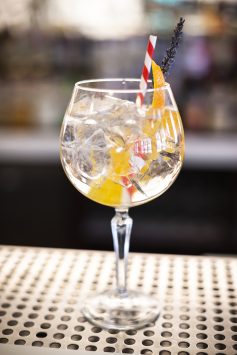
Spanish G & T
- 2 oz. Vanagandr Gin
- 6 oz. of your favorite tonic (We like Thomas Henry or Fever-Tree)
Fill a large balloon wine glass with ice, adding gin and tonic water made with real sugar. Go crazy with garnishes! We kept it simple with dried lavender and orange peel, though you can easily add a cinnamon stick to highlight that particular botanical.
While there is no wrong way and no wrong time to enjoy any of these lovely and unique gins, we hope you’ll enjoy these “right” ways to enjoy a gin cocktail – or, as Yoni of Neversink suggests, all by itself! Cheers and happy drinking.




